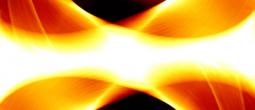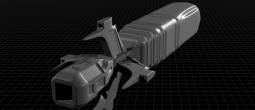

Power Systems
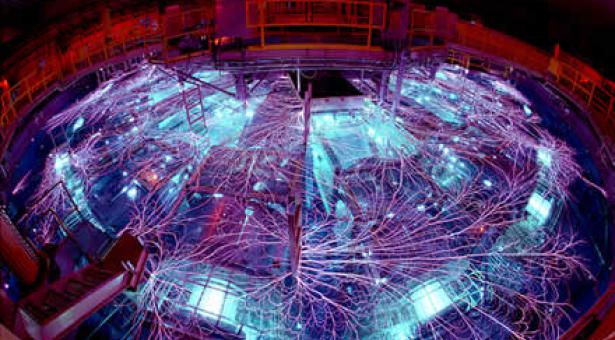
Shipboard power is supplied by a pair of magneto-inertial fusion reactors, supplemented by auxiliary and emergency power generation systems.
Power is distributed throughout the vessel by the Power Distribution Network (PDN), a highly redundant web of nodes connected by power conduits that is designed to allow the routing of power around damaged or defective parts of the network.
The PDN also provides monitoring of the operating status of ship systems connected to it.
Power Generation
The power generation system has three operating layers.
Main Power
The main generation system consists of a pair of magneto-inertial fusion reactors. While this technology is public knowledge, it had not moved beyond the experimental phase before being secretly adopted by the ISDC and significantly improved using alien-derived superconductor technology.
The reactors produce power to meet the enormous demands of the main engines, the superluminal drive system and tactical systems. While the output of the reactors is not sufficient for them to operate as a redundant pair, a single reactor can still generate enough power to return the vessel to base in an emergency.
Auxiliary Power
The auxiliary generation system consists of a number of PEM fuel cell generators which can provide power for extended periods.
The auxiliary generation systems are intended to keep vital ship systems running in the event of main system failure, including life support, communications, limited sensors and some defence systems until such time as main power is restored.
The auxiliary systems do not provide sufficient output to operate main engines, superluminal drive or the torpedo system.
Emergency Power
Emergency power is provided by a series of battery-based Uninterruptable Power Supply (UPS) systems throughout the vessel.
These systems are intended to provide temporary power to cover any interruption of supply between main system failure and the availability of auxiliary power to vital ship systems.
Power Distribution Network
The Power Distribution Network (PDN) is a web of power supply conduits interconnecting distribution nodes. The nodes provide control, monitoring and power conversion capabilities.
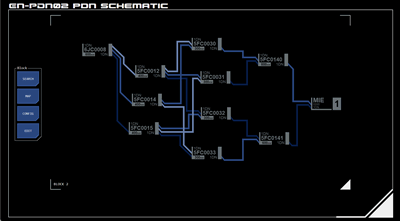 The PDN is designed to be heavily redundant, allowing power to be routed around damaged sections.
The PDN is designed to be heavily redundant, allowing power to be routed around damaged sections.
Control consoles display schematic maps of the network to assist with power distribution and allocation.
Distribution Standards
The PDN operates three power standards to support the requirements of a range of ship systems.
Standard 1DN uses a high-voltage DC power standard and supplies power from the reactors to core distribution nodes. 1DN also directly supplies systems with very high power requirements such as the main engines, superluminal drive and the torpdeo system.
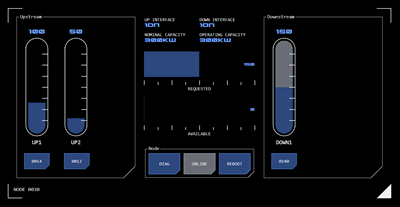 Standard 2DH uses a high frequency AC standard to supply edge distribution nodes and systems with large power requirements such as environmental, weapons and sensor systems.
Standard 2DH uses a high frequency AC standard to supply edge distribution nodes and systems with large power requirements such as environmental, weapons and sensor systems.
Standard 2DL uses a low frequency AC standard to supply control consoles, computer equipment, lighting, galley equipment, etc.
Distribution Nodes
Distribution nodes accept power from multiple upstream sources and distribute it to multiple downstream nodes. During distribution the power standard may also be converted (depending on the type of node).
Requests for upstream power and allocations to downstream nodes are controllable for individual nodes. The status of each node is monitored via diagnostic codes.
System Nodes
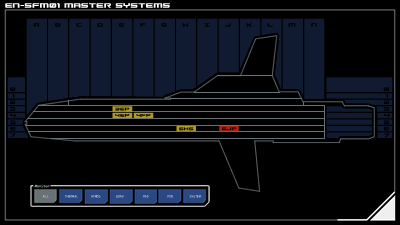 System nodes are a variant of distribution nodes that supply power directly to a ship system. Only upstream power requests are configurable.
System nodes are a variant of distribution nodes that supply power directly to a ship system. Only upstream power requests are configurable.
System nodes also provide monitoring of the system they supply via a set of diagnostic codes specific to that system. The system node's control interface is accessible directly from a button on the system's control console along with a master alarm interface which displays the system's basic status - offline, unavailable (damaged), available or online. A diagnostic reporting interface is accessible directly from the system's master alarm button.
System status based on active diagnostic codes is also displayed on the Master Systems console.


